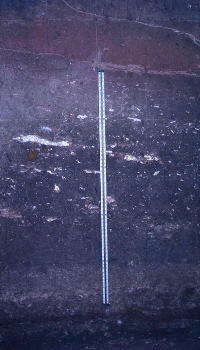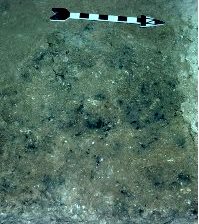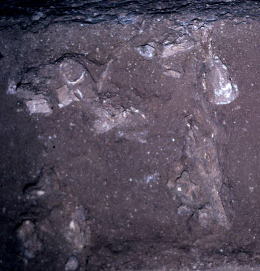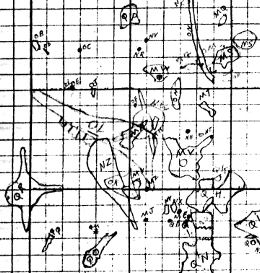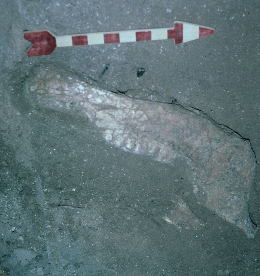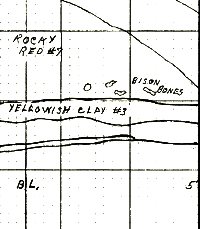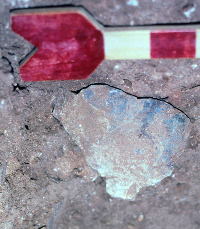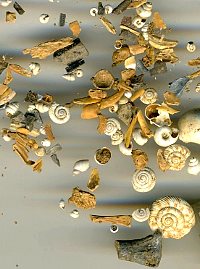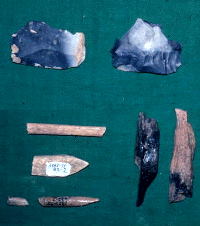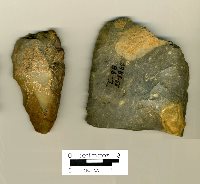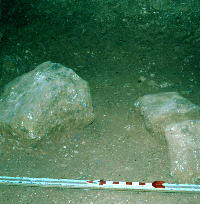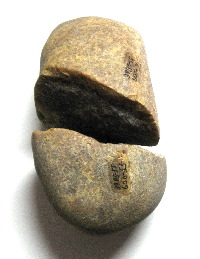
|
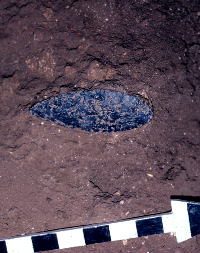
|
Stratum 7: Rocky Red
Nearly four feet in thickness, this stratum consists of reddish brown sandy clay, containing many angular fragments of limestone. Cultural materials are scattered throughout, including three San Patrice and two unclassified, expanding-stemmed dart points; a bison bone bed and a fire hearth with a radiocarbon date of ca. 10,600 years B.P. was uncovered at the lowest levels.
Extending upward from the yellowish clay layer near the bottom of the shelter to the red-white spotted Sub-Stratum 8D, Stratum 7 is positioned toward the front of the cave deposit, where the interface is uneven and difficult to discern. A portion of this stratum lies outside the overhang. Horizontal fingers of cave deposit occasionally extend into this stratum, but the deposits outside the drip line are very different in texture and appearance.
For the excavators, this stratum has been somewhat of an enigma. Redder noted: "At first we wondered if this was the redeposition of another archeological deposit. Then a broken quartzite stone was found, half in the cave deposit and half in this stratum. San Patrice points ("Brazos Fishtails") also were found in this stratum near the 5-foot north-south line. With these findings, we then decided Stratum 7 may be contemporary with the cave deposit and may represent a slow build up."
Roughly 5 feet west of the baseline, two small, Archaic-looking, expanding-stem dart points were found in a single excavation unit, at approximately the same depth at which the San Patrice points were recovered nearby. One of the expanding stemmed points was found in situ; the other was found in two pieces, one in the screen, the other in the wall.
Redder wrote at the time, “I could discover no reason for an Archaic-looking point being at this depth. Clearly a long hard look must be taken at the remainder of this stratum.”
To some, these points resemble certain Late Paleoindian/Early Archaic points. Archeologist Michael Collins has suggested (based on looking at a photo) that one may be related to type Big Sandy, the other a resharpened Wilson point. The two points also bear similarities to San Patrice variants at sites in the midwest, such as Big Eddy.
Deeply buried at the base of Stratum 7 in Horn Shelter was an extensive concentration of burned and unburned animal bone, including bison, deer-sized animal, small mammals, and fish. A few chipped-stone tools, chert flakes, red ocher, and charcoal fragments were scattered among these, along areas of burned earth. Based on size and robusticity, the bison was Bison antiquus. The bones of this animal were not articulated, nor were all elements present. Portions of the bison bone were jacketed in plaster for removal.
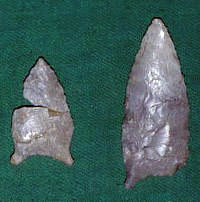
|
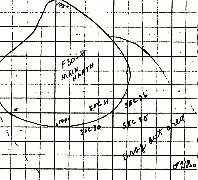
|
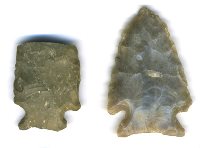
|
